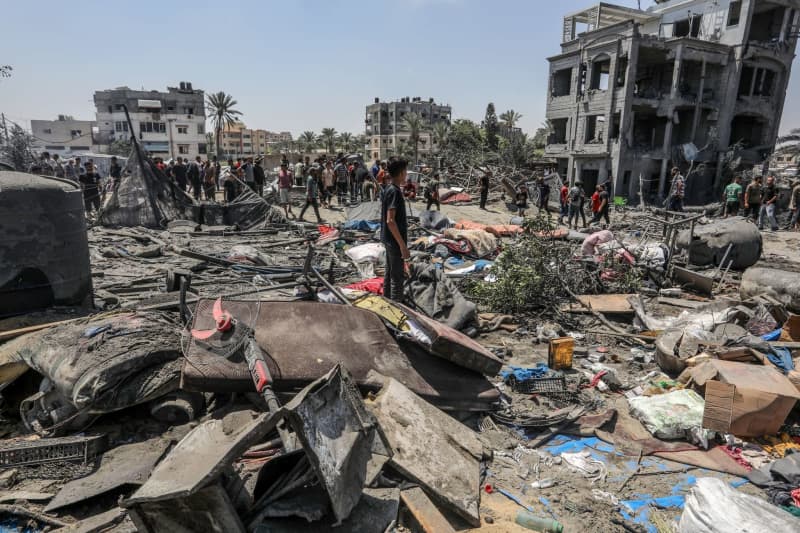Ahmed Mduch thought he would only leave his home for a few hours when he was ordered to evacuate by the Israeli army, three days into the war in Gaza.
Israeli forces were preparing to attack nearby buildings believed to belong to the Palestinian Islamist Hamas, as Israel responded to the October 7 attacks.
That was a year ago.
Mduch, 45, and his family are still waiting and longing to go home.
The Israeli Air Force began attacking targets in the Gaza Strip hours after attacks by Hamas and other extremist groups in southern Israel, killing 1,200 people and kidnapping up to 250.
But it is mainly the civilian population in the now largely destroyed strip that pays the price.
About 90% of residents of the densely populated Gaza Strip have been displaced at least once during military operations launched by Israel in its bid to eliminate Hamas.
The fighting was initially heaviest in Gaza City, where Mduch and his family lived.
They fled their homes, but that was only the first time. Over the past year, he, his wife and his four children have been forced to flee repeatedly.
“Every time we are displaced and have to move to another place, we lose our belongings, a piece of our dignity and our will to live,” he told dpa.
They are now camping in the city of Deir al-Balah, in the south of the Gaza Strip.
Their tent measures less than 9 square meters, says Mduch, who used to work as an actor. Unsurprisingly, it has no toilet, water or electricity, and no protection from heat or rain.
“We flee death, but flee to hell,” he says.
The same goes for most of the 2.2 million people living in the Gaza Strip, many of whom have also repeatedly fled to temporary housing. They are the survivors.
About 41,870 Gazans have been killed so far, most of them women and children, according to the Hamas-controlled Health Ministry. The figures cannot be independently verified and do not distinguish between fighters and civilians, but the UN has said the Gaza health authority figures are generally credible.
And the death toll continues to rise daily, even as the world’s focus now turns to increasing hostilities on the Lebanese border as Israel battles the Shiite Hezbollah militia.
The end of the war in Gaza is not yet in sight. Indirect ceasefire talks have been stalled for months between the Israeli government and Hamas, mediated by the US, Qatar and Egypt.
As the Israeli invasion, airstrikes and ground offensive continue, many residential areas in the Gaza Strip lie in ruins.
The Israeli military accuses the Islamist organization of misusing hospitals, schools and homes for terrorist purposes and using people as human shields, charges Hamas has denied.
About 59% of all buildings in Gaza were damaged, if not completely destroyed, between the start of the war and July 2024, US researchers using satellite data say. This amounts to approximately 170,000 buildings on the 40 kilometer strip.
Humanitarian areas under attack, Palestinians say
The gray ruins of buildings and mountains of rubble dominate the northern part of Gaza.
Abdullah Masud fled from the Al-Shati refugee camp, west of Gaza City, in December last year.
He and his family first found shelter in Al-Mawasi, in the south of the strip designated as a ‘humanitarian zone’. There was no water, no electricity and no medicine, says Masud, who is 44 but looks years older.
He says the Israeli army has also carried out attacks in this area, even though it should be protected.
Masud, who used to be a bank employee, says what sticks in his mind is the airstrike that killed Hamas military leader Mohammed Deif in July.
“I will never forget the enormous flames,” he says.
People fled in panic as the fire raged, while the remains of bodies lay on the ground. Ninety people were killed in that airstrike, the area’s health authority said.
As people ran, panic caused Masud, a father of five, to shout out loud the names of his family. They survived.
The Israeli army said it had bombed a Hamas fenced compound inside the humanitarian zone. Deif is said to be one of the masterminds of the attacks of October 7, 2023.
Gazans get a meal every other day, aid groups say
Masud and his family then moved to a tightly packed refugee camp in Deir al-Balah, a little further north.
Given the horrific situation, he often wishes he were dead, he says.
He has lost almost 25 pounds since last year, he says, and now weighs 75 pounds.
Israel’s restrictive controls mean food and aid are scarce, with 83% of needed food aid not reaching the strip, according to Care and other aid groups.
That means people in Gaza have gone from an average of two meals a day to just one meal every other day.
Tens of thousands of children are malnourished.
Only 17 of the 36 hospitals in the strip are partially operational.
Care, Save the Children and other non-governmental organizations have criticized Israel’s controls on aid, including medicines. Israel rejects the criticism.
“If we were to add up the damage caused by the war, it would not be possible,” says Khaled Al-Frandschi, who is also from Gaza City but is now also in Al-Mawasi.
“I hope this war will end soon.” People finally need security, including to rebuild the Gaza Strip, he says.
According to researchers, reconstruction could take decades.

